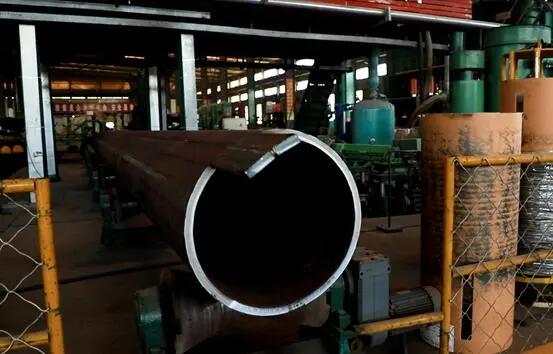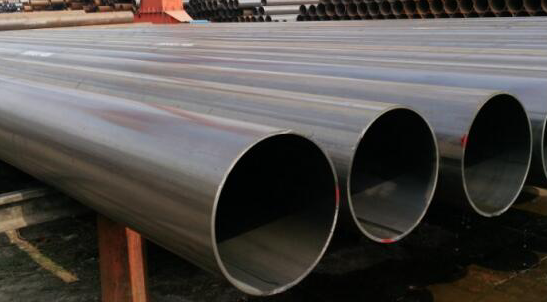
Straight Seam Submerged Arc Welded Steel Pipe vs. Straight Seam High Frequency Welded Steel Pipe
Straight seam steel pipe knowledge:
Straight seam steel pipe is a type of welded steel pipe. It refers to a steel pipe in which the weld seam is longitudinally parallel to the steel pipe. Its production process is relatively simple and the overall cost is low. It has a variety of diameters and wall thicknesses that can be customized and selected. It can produce large-diameter, thick-walled straight steel pipes.
How to process and produce straight seam steel pipes? There are two main methods of forming straight seam steel pipes: straight seam submerged arc welded steel pipes and straight seam high-frequency welded steel pipes. What's the difference between the two? This will be described in detail below.

Straight Seam Submerged Arc Welding vs. Straight Seam High Frequency Welding
1. Steel plate inspection: For steel plates used in the production of large-diameter straight seam submerged arc welded steel pipes, a full-plate ultrasonic inspection will be performed first. If there is no damage or damage, the next production process will be entered;
2. Edge milling: Use a milling machine to double-side mill the two edges of the steel plate to achieve the required steel plate width, steel plate edge parallelism and bevel shape;
3. Pre-bending edge: Use a pre-bending machine to bend the edge of the steel plate to obtain the required arc of the steel plate;
4. Forming: The first half of the pre-bent steel plate is stamped multiple times and pressed into a "J" shape on the JCO forming machine. Then, the other half of the steel plate is also bent and pressed into a "C" shape, and finally an open "O" shape;
5. Pre-welding: The formed straight seam welded steel pipe joints are continuously welded by gas shielded welding (MAG);
6. Internal welding: longitudinal multi-wire submerged arc welding (up to four wires) is used to weld the inside of the straight seam steel pipe;
7. External welding: longitudinal multi-wire submerged arc welding is used to weld the outside of the longitudinal submerged arc welded steel pipe;
8. The first ultrasonic inspection: inspect the internal and external welds of the straight seam welded steel pipe and the base metal on both sides of the weld;9. The first X-ray inspection: X-ray industrial television inspection of internal and external welds, using an image processing system to ensure the sensitivity of flaw detection;
10. Diameter expansion: The entire length of the submerged arc welded straight seam steel pipe is expanded to improve the dimensional accuracy of the steel pipe and improve the distribution of stress within the steel pipe;
11. Hydraulic pressure test: The expanded steel pipes are inspected one by one on a hydraulic pressure testing machine to ensure that the steel pipes meet the test pressure required by the standard. The machine has automatic recording and storage functions;
12. Chamfering: Process the pipe end of the steel pipe that has passed the inspection to achieve the required pipe end bevel size;
14. The second X-ray inspection: X-ray industrial television inspection and pipe-end weld photography on the steel pipe after diameter expansion and hydraulic pressure test;
15. Pipe End Magnetic Particle Inspection: This inspection is performed to detect pipe end defects.
16. Anti-corrosion: Finally, the product is treated with anti-corrosion coating.

Straight seam high frequency welded steel pipe (ERW Pipe) production process:
The high-frequency welding process is based on the principle of electromagnetic induction, as well as the skin effect, eddy heat flow effect and proximity effect of AC charges in the conductor. The edge steel of the weld is heated until it is heated to a molten state, and then Using the roller extrusion process, the butt welds can achieve intergranular bonding, so that the purpose of welding can be achieved.
High-frequency welding is a type of induction welding, which we can also call pressure-based welding. High-frequency welding does not require filler materials for the weld seam, and there is no welding spatter during welding. The area affected by the welding heat during the welding process is narrow, the shape after welding is very beautiful, and the mechanical properties of the welding are very good. Due to these advantages of high-frequency welding, high-frequency welding has been widely used in the production of steel pipes.
High-frequency welding of steel pipes utilizes the skin effect and proximity effect of alternating current. After the steel is rolled and formed, a circular tube blank with a broken cross-section is formed. Rotate one or a group of resistors in the tube near the center of the induction coil, and the resistor and the opening of the tube form an electromagnetic induction loop. Under the action of skin effect and proximity effect, the edge of the opening of the tube blank generates a strong and concentrated thermal effect, causing the edge of the weld seam to quickly heat to the required welding temperature. After being extruded by the pressure roller, the molten metal achieves inter-crystal bonding, and forms a strong butt weld after cooling.
The above are the two production processes of straight seam steel pipes. In daily life, straight seam steel pipes can be processed into various bends, elbows and other pipe components. They are not only strong and durable, but also low in cost of use.


